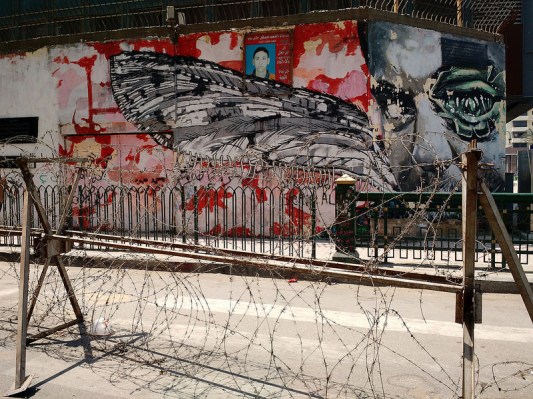Remember 2011? The Arab Spring, a.k.a. “Revolution 2.0“? Four governments were overthrown. The stage was set for further social-media-fuelled protests: Brazil. Ukraine. Turkey. It seems awfully apparent, now, that Facebook and Twitter can serve as a potent catalyst of eruptions of revolutionary fervor —
–and equally apparent that that isn’t nearly enough to actually liberate the oppressed.
The Arab Spring was followed, retrograde, by an Arab Winter. Today, civil war rages in Libya, Syria, and Yemen; pitched battles against Daesh (aka ISIS) are fought daily in Kurdistan and Iraq; even Tunisia, the revolution’s greatest hope, is at best still struggling.
I write to you from Cairo, where Tahrir Square is still festooned with barbed wire and newly built walls. Masked soldiers guard a line of armored personnel carriers lurking just outside the Egyptian Museum on the north end of the square. Immediately below, Sadat subway station has been closed since 2013, after sit-ins protesting against the coup d’etat that deposed elected Islamist president Mohamed Morsi. That is the rough equivalent of shutting down Times Square subway station for two years for security reasons.
I hate to get all Thomas Friedman on you, but I was struck by how multiple taxi drivers spoke wistfully to me of the stability of the Mubarak regime, and the millions of tourists who flooded into the country back then. Nowadays, in both Jordan and Egypt, tourists have become something of an endangered species.
What happened? The dreams of 2011 and 2013 were that technology would make governments more accountable to the people, not that newly networked nations would disintegrate into (highly sophisticated) civil war, or that, after a brief period of instability, the new boss would be essentially the same as the old boss. Where was Revolution 2.0 betrayed?
The same place revolutions are usually betrayed: the aftermath. It’s one thing to channel an entire population’s frustrations into a single titanic, decisive eruption. Social media can help do that. (As can anything that can draw people together and helps them communicate, of course — but modern technology can bring together far more people, faster, than any samizdat of old.) It’s quite another to set up a representative democratic government with strong civil institutions, especially in fragmented nations still wracked by deep poverty which have been forced by tyrants into a fragile, artificial, iron-fist-imposed “stability” for decades.
Given sufficient wealth and technical infrastructure, could new networked governments and institutions be constructed and sustained on the fly, by smart and capable people (like Egypt’s Wael Ghonim) who find themselves guiding / riding the wave of revolution? Eventually, theoretically, yes. Could that happen in, say, Egypt today? Of course not: not even close. Estonia, maybe, but Estonia doesn’t need a revolution.
The dark irony is that much of the world is developed enough that technology can help its oppressed join together into powerful movements, far more easily than would have been possible even a decade ago — but not yet developed enough that the slow, painful, and brutally difficult process of rising from the ashes of the old regime has gotten any easier. Maybe in a decade, he said optimistically. But for now, Revolution 2.0 remains an invitation to chaos–just as 1.0 always was.
